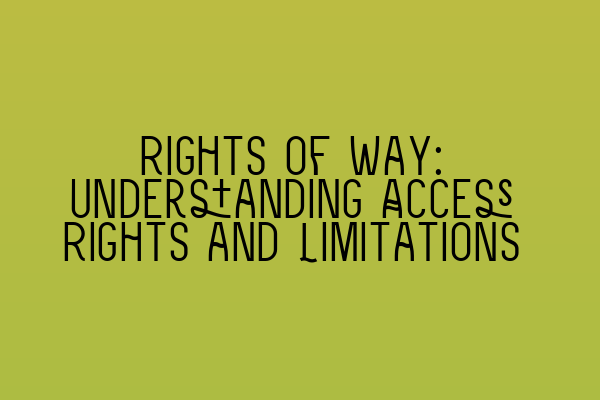Rights of Way: Understanding Access Rights and Limitations
As a property owner or someone looking to purchase a property, it is essential to have a clear understanding of the rights of way, as they can significantly impact your property’s value and use. In this blog post, we will delve into the intricacies of access rights and limitations to help you navigate this complex area of property law.
What are Rights of Way?
Rights of way are legal rights that enable individuals to travel across or use another person’s land. These rights are established through a legal agreement, either explicitly in a written document or implicitly through long-term usage. In some cases, rights of way can be public, allowing anyone to use the specified route, while in other cases, they can be private, benefiting only specific individuals or properties.
Types of Rights of Way
There are several types of rights of way, including:
1. Public Rights of Way: These are rights that are available to the general public, allowing them to access certain areas for recreational purposes, such as footpaths, bridleways, and byways. Public rights of way are typically maintained by local authorities and are governed by legislation, ensuring their preservation and accessibility.
2. Private Rights of Way: These rights are restricted to specific individuals or properties and grant them access to certain areas of land. Private rights of way can arise through a variety of means, such as a legal agreement, historical usage, or implied necessity. It is important to note that private rights of way can vary in terms of their extent and limitations.
3. Easements: Easements are legal rights granted to individuals or properties that allow them to use part of another person’s land for a specific purpose. While rights of way primarily focus on access, easements encompass a broader range of uses, such as laying utility lines, drainage, or even light and air.
Limitations and Restrictions
While rights of way provide certain entitlements, they also come with limitations and restrictions. It is crucial to understand these limitations to avoid potential disputes or legal complications. Here are some common limitations to be aware of:
1. Purpose Limitations: Rights of way are typically granted for a specific purpose, such as pedestrian access or agricultural use. It is important to ensure that the activities conducted on the land align with the intended purpose of the right of way.
2. Maintenance Obligations: In most cases, the owner or user of a right of way is responsible for maintaining it, including repairs, upkeep, and clearance. Understanding your maintenance obligations is essential to avoid disputes and ensure the smooth access to the property.
3. Exclusivity: Depending on the terms of the right of way, there may be restrictions on its exclusivity. Some rights of way may allow multiple individuals or properties to use the same access route, while others may restrict access to only one user.
4. Termination: Rights of way can be terminated or revoked under certain circumstances. Changes to the land, abandonment, or the expiration of any time limits specified in the agreement can result in the termination of a right of way. It is advisable to seek legal advice to understand the conditions and procedures involved in terminating a right of way.
Resolving Disputes
Disputes related to rights of way can arise due to various reasons, such as a disagreement over usage, maintenance, or the extent of the right. It is always recommended to try and resolve any disputes through negotiation or mediation before resorting to legal action. Seeking professional legal advice is crucial to understanding your rights and obligations and finding a satisfactory resolution.
Conclusion
Understanding rights of way is crucial for property owners and potential buyers to ensure smooth access to their land and avoid legal disputes. Whether it is a public right of way or a private easement, knowing the scope, limitations, and restrictions of these rights is essential in making informed decisions about your property.
If you’re preparing for the SQE exams and looking for practice resources, check out our related articles:
– [SQE 1 Practice Exam Questions](https://fqps.co.uk/sqe/sqe1-preparation/mcq-practice-quiz)
– [SQE 1 Practice Mocks FLK1 FLK2](https://fqps.co.uk/sqe/sqe1-preparation/practice-mocks-quiz)
– [SQE 2 Preparation Courses](https://fqps.co.uk/sqe/sqe2-preparation)
– [SQE 1 Preparation Courses](https://fqps.co.uk/sqe/sqe1-preparation)
– [SRA SQE Exam Dates](https://fqps.co.uk/sqe/sqe1-sqe2-exam-dates)
At SQE Property Law & Land Law, we have a team of expert solicitors who specialize in property-related matters. If you require legal assistance or advice regarding rights of way or any other property law issues, please do not hesitate to get in touch with us. We are here to help you navigate the complexities of property law and protect your rights.
